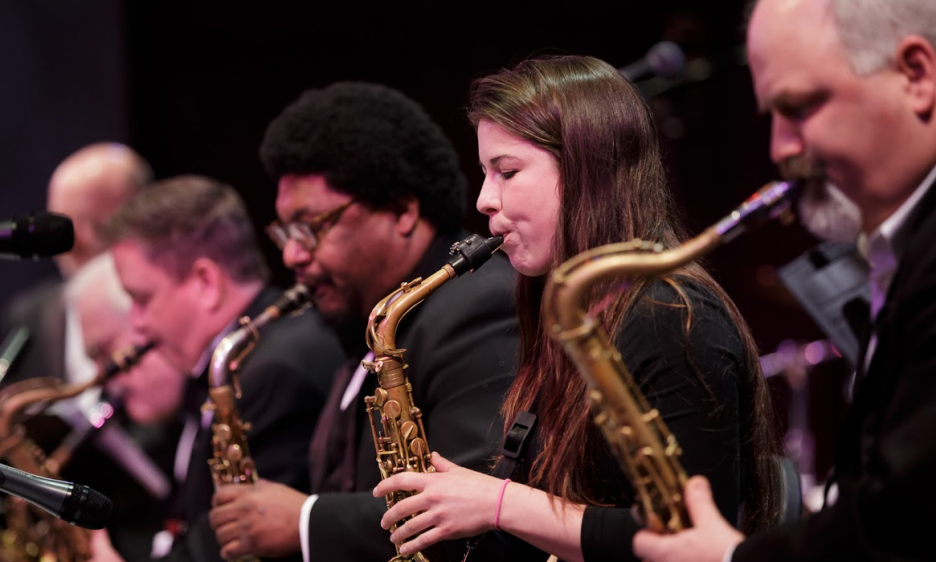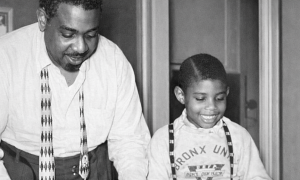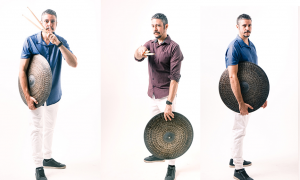Home » Jazz Articles » Interview » Sidney Hauser: Justice and Jubilation
Sidney Hauser: Justice and Jubilation

Being a woman player, you feel like you have to put on this smiley face, and be what everyone wants you to be. I feel like I have to represent myself to a higher degree than my male counterparts. I’m really hard on myself. If I feel like I’m not performing in a way that represents female players well, I get really upset.
—Sidney Hauser
While the hiring of a young northwest musician may not seem surprising, considering the culture and competitive success of high school jazz programs in the Seattle area, Hauser's personal journey involves a litany of unlikely circumstances.
SRJO was founded by University of Washington Artist in Residence Michael Brockman, and Clarence Acox, whose Seattle high school jazz band at Garfield High School has won the highly regarded Essentially Ellington competition at Lincoln Center an unprecedented four times. "Clarence is a marvelous advocate for anyone who wants to play this music," says Brockman with admiration. Along with Roosevelt High School band director Scott Brown, Acox has propagated a culture that has spread throughout the greater Seattle area, with real results at Lincoln Center, the most prestigious high school band festival in the world.
Hauser does not hail from one of these celebrated programs, boasting a history of graduates that include Quincy Jones, Ernestine Anderson, and Thomas Marriott. She was raised in the comparative cultural isolation of Whidbey Island, separated from Seattle by thirty miles and a ferry ride across Possession Sound.
Boarding the ferry in the seaside village of Mukilteo, one's senses are filled with salt air, the cries of seabirds, and a sweeping vista of high mountain peaks, hidden coves, and Tahoma sitting like Buddha in peaceful repose to the south. The southern portion of the island is served by South Whidbey High School, where a jazz culture is being launched by inventive and resourceful band director, Chris Harshman. Indeed, Harshman vaulted the program into the same lofty status as Garfield and Roosevelt in 2008, taking his group of islander musicians to Essentially Ellington. South Whidbey's arrival prompted one east coast band director to ask Harshman, "Is there something in the water out there?" At that point, prodigious pianist Aaron Parks was the island's only claim to jazz recognition.
Still, Hauser was not raised in a household surrounded by jazz, and her interest in the music had not yet come to light when she decided to study the clarinet for social reasons apart from her instinct to play trumpet. Most importantly, she was given a choice aside from the generational gender assignment of instruments that has plagued young girls for decades in public schools across the country. She was attracted to strong sounds, to instruments prominently front and center in jazz culture.
Her senior year, the South Whidbey band took first place at the Lionel Hampton Jazz Festival in Moscow, Idaho, with Hauser securing first place in the alto saxophone soloist category for her performance of "When Sunny Gets Blue."
"Lionel Hampton was definitely a rewarding and enlightening experience," says Hauser. "No matter how good you think you are, there are always people one step ahead of you, or more. Lionel Hampton is so unique, because you become exposed to a whole spectrum of players, from mediocre to prodigy, yet you all have one thing in common-a love for music." Hauser's interest in jazz began to include saxophonists Sonny Stitt, Joshua Redman, Art Pepper, and Cannonball Adderly, spending considerable time transcribing solos from them all.
"I didn't practice very much until I got to high school and heard the jazz band. Then I started taking lessons from Neil Welch, and that got me more into jazz, recalls Hauser. She then moved on to take lessons from prominent Seattle alto saxophonist Mark Taylor her senior year, a weekly jaunt that involved ferry rides bouncing on the wintry, dark waters of Salish Sea. "I would commute over to take a lesson from him every week. He's one of my biggest inspirations in terms of having a role model for what I want to sound like. I love his sound on tenor and alto," says the young altoist.
Hauser entered the University of Washington the following fall, but was unhappy with the direction of the jazz culture there. Under the auspices of avant-garde trumpeter Cuong Vu, drummer Ted Poor, and guitarist Bill Frisell, the program had taken on an experimental bent that did not interest her. This occurred despite the strong presence of Brockman, and pianist Marc Seales. She decided to major in fine arts, to pursue her love of painting and drawing, and the sense of imagination and inspiration that accompanies her significant talents. Nonetheless, Brockman was impressed with the young saxophonist, recognizing her strong ensemble playing in the UW Wind Ensemble. "Brockman was great, he helped me get through my frustration, and there was a lot of it," recalls Hauser. "She was one of my favorite students of all time, just because of her attitude," said Brockman recently, brandishing a smile that reflected his confidence in, and admiration for his former student, and current colleague.
Hauser's foray into visual art studies, coupled with her independent pursuit of music provided artistic parallels that played off each other, each accentuating the creative processes and impulses that produce personally expressive art. For Hauser, there are indeed distinct commonalities between the two. "I approach music the same way that I would approach a painting, in terms of the process. It starts with an idea, a basic conceptual foundation that I keep adding to. In music, it may be adding harmony, or in painting, adding new layers of color. The color wheel is similar to the circle of fifths," she states thoughtfully. Pianist Hal Galper often refers to playing jazz in his trademark rubato style as being similar to cubist painting. Indeed, the metaphor is striking, the visual concept of all the elements being there, yet with many of them out of place, and emphasized in different variables.
Hauser's post college resume as a jazz saxophonist is to some degree, bare boned. She plays with a fusion style band named Smack Talk, and contributes to several other bands as a side musician. Her selection by Brockman to fill the saxophone chair made available by the virtual retirement of legendary baritone master Bill Ramsey was initially received by the Seattle jazz community with a sense of both surprise and delight. It raised many questions both musically and sociologically.
From Hauser's point of view, she had been experiencing the same biases, having to leap over the same hurdles women instrumentalists in jazz have endured since the days of prohibition. "I feel that men have lower expectations of female players. They compare us to other females rather than the general population. I don't want to be that girl that is slightly better than you thought," states Hauser emphatically.
SRJO's history of hiring women was scant, to say the least. Tobi Stone had played in the saxophone section in recent times, but Brockman's focused efforts to welcome female musicians to the band had resulted in brief tenures, and guest appearances. Stone was first altoist, and was joined briefly by Lisa Gordanier, as well as bassist Laura Welland. Trombonist Jenny Kellogg was offered a place in the band, but opted to attend school at North Texas State, eventually landing on the faculty at Eastern Washington University. French horn virtuoso Danielle Kuhlman, a Garfield graduate, has guested on several occasions, and is now the principal at the Seattle Symphony.
Hauser was approached by Brockman to sub on several occasions, always unable to due to other obligations. "Michael Brockman had asked me to sub in the band a few times, but I had prior engagements. When I finally could, Bill Ramsey was playing his final concert. Brockman and I had always had a really good connection," she recalls, "Michael and I play really well together, we have a similar sound on the alto."
There were some comments around the jazz scene in Seattle that Brockman was fulfilling some sort of quota in hiring Hauser, comments that were abhorrent in so many ways, yet somewhat understandable considering that she did not have what one would consider an extensive resume for the position. Those who had awareness of her talents though were delighted and confident in her appointment. There was a sense of both justice and jubilation. Everything else aside, Hauser can flat out play, can flat out swing, and possesses specific abilities that are essential to playing in a big band. While many saxophonists active on the scene playing in smaller combos may have seemed to be more likely candidates, Brockman saw qualities from his old student that immediately came to mind when the thought of replacing an icon like Ramsey became reality.
"She has a voice in jazz that is a different style than anybody in our band," says Brockman, noting several specific talents adding, "She's an extremely well-trained musician." As second altoist, the disciplines necessary for the job, are vividly evident, disciplines apportioned generously within Hauser's skill set. "Being able to read music extremely well makes a session player very valuable," he adds. Hauser as well alludes to the role she plays in the band, recognizing those aspects of her musical persona that make her a perfect fit for the band. "Because I'm second alto, I have to know when to not play. I'm used to being the lead. When you're in bands like SRJO, there has to be a hierarchy of sound." As to the sociological fallout from hiring a young woman, Brockman states, "There are social biases that girls have to overcome. They have to stand out in a crowd and be different."
While Hauser is having success in SRJO due to her outstanding talent, she as well is inherently becoming a role model for young girl musicians regionally, a phenomenon she never experienced herself coming up.
"I had a lot of male mentors that I looked up to, but I can't think of a single female. I hope that I can be what I was missing when I was younger," she says.
Such sentiments are common with the current generation of female jazz instrumentalists that are literally changing the face of America's quintessential art form. New York-based, Seattle born and raised saxophonist Roxy Coss expressed this on her recent release, The Future Is Female (Posi-Tone, 2018). Coss, who also engages in gender justice activism through her efforts with the Women In Jazz Organization (WIJO), included an original composition on the record aptly named, "She Needed a Hero, So That's What She Became." It expresses the similarities experienced by women throughout jazz history.
"One thing that stands out for me after meeting all these other women is we all have had a very similar experience. Almost everyone I have talked to has been sexually abused, harassed, or assaulted by male jazz mentors at some point. A lot of us have multiple instances of that. It can be anything from extremely overt, like rape, to just very subtle ways of manipulating power over you," states Coss emphatically.
Hauser accepts and is inspired by, the tradition, and responsibility that comes with being a mentor. "It's a lot of good pressure, to want to live up to expectations. When I was in high school, I wanted that female mentor to look up to, but it was hard to find, being in a jazz program with a lot of dudes. It was hard for me to find my own mentor. I hope to be a mentor for other girls in music programs, who can look up to me, and think, 'that could be me.' "
The current movement for gender justice in jazz, coinciding with the power and strength of the #MeToo movement, is exacting change on the landscape of jazz. While wholesale change is a generational movement exemplified by the increasing numbers of female musicians graduating from high school programs and advancing to institutions of higher learning, immediate change is also on the docket. Wynton Marsalis' Jazz at Lincoln Center Orchestra, to this point a boys club in the first degree, has implemented blind auditions much like symphony orchestras to assure hires based on talent and not gender. The new selection procedures include blind auditions, formal job postings, and wider outreach about openings, all of which will help attract a broader pool of applications. In particular, blind auditions have been widely credited with increasing the representation of women in symphony orchestras from less than 5% of players in the 1970's, to close to 50% today. It has not resulted in increased opportunities for women as conductors or musical directors.
For Hauser, the issue is personal, both in a societal sense and in how she sees herself and her efforts to pursue her passion for music. "I like being abrupt, you get stuff done. Being a woman player, you feel like you have to put on this smiley face and be what everyone wants you to be. I feel like I have to represent myself to a higher degree than my male counterparts. I'm really hard on myself. If I feel like I'm not performing in a way that represents female players well, I get really upset," she says with an honesty that exudes strength and confidence.
In her inaugural season with SRJO, Hauser has been given the opportunity to perform with two remarkable female voices in jazz. This past month, veteran vocalist Dee Daniels performed with the band. "I saw her play at Port Townsend, and was inspired by her singing," she says excitedly. During Hauser's lone solo during the Ellington classic, "Caravan," Daniels stood strongly upright, with a smile that expressed joy and satisfaction while Hauser delivered an arching chorus that brought the audience to their feet. It was a moment caught artfully by SRJO photographer, Jim Levitt. "I was thinking that Dee must be enjoying seeing and hearing a woman in this otherwise all-male band," says Levitt, Seattle's most active jazz photographer. Indeed, not only was Hauser present, but tenor saxophonist Kate Olson was subbing for the three day run as well. Added Levitt, " It's even better, there are two women. It's about time! Otherwise, it struck me as perfectly normal, because I see a lot of young women at the high school level, and I also photograph the Seattle Women's Jazz Orchestra of which Sidney is a part for a few years now."
Next month composer/arranger/bandleader Maria Schneider, perhaps the most prominent female artist in modern jazz, arrives in Seattle for three performances with the band. Trepidation concerning her flute playing aside, playing with Schneider is an opportunity she genuinely appreciates, understanding the forward steps she will be taking in a professional sense.
Hauser adds to the saxophone legacy being created by female artists in modern jazz, whether it be that of fellow alto saxophonists Tia Fuller and Alexa Tarantino, tenor/soprano master Roxy Coss, or baritone phenom Lauren Sevian. They are obliterating the negative stereotype that has accosted women horn players historically. She need not look beyond the Pacific Northwest to find strong female mentorship in this sense, in the form of trumpeter Ingrid Jensen, her sister, saxophonist Christine Jensen, and the aforementioned Coss.
While jazz music has become institutionalized in modern times, much like European classical music, Hauser has largely learned her craft outside of the walls of academia. Her sound is very much like her personality-fresh, confident, and fun loving, unfettered by the constraints of institutionalized learning. There is a jubilant quality to her playing that promises an open mind to the myriad of influences she is sure to encounter on her musical journey. She states that she has so much listening to do, and it is true that her knowledge of the classic players and recordings, and of current masters of the art is, to some degree, lacking. She possesses the foundational musings of Bird and Cannonball, the open-mindedness of Woods, and to a lesser extent, the chromatic, uncompromising logic of Dolphy. Yet, there is an uncommon uniqueness to her sound, one that embraces and reflects her ardent individualism. It is a sound that is mindful of the eclectic nature of Seattle jazz culture, and pays homage to those weekly sailings from Whidbey Island to the mainland, seeking the wisdom and mentorship of Taylor. Her seat in the saxophone section of the Seattle Repertory Jazz Orchestra is likely to serve as a springboard to other opportunities, to engage in and assimilate different sounds. The palette of colors she acquires in the process will determine the images she engages, and shares with us moving forward.
Photo credit: Jim Levitt
Tags
Interviews
Paul Rauch
United States
Washington
Seattle
Sidney Hauser
Clarence Acox
Scott Brown
Quincy Jones
Ernestine Anderson
Thomas Marriott
Chris Harshman
Aaron Parks
Sonny Stitt
Joshua Redman
Art Pepper
Cannonball Adderly
Neil Welch
Mark Taylor
Cuong Vu
Ted Poor
Bill Frisell
Marc Seales
Hal Galper
Bill Ramsey
Tobi Stone
Roxy Coss
Dee Daniels
Kate Olson
Maria Schneider
Tia Fuller
Alexa Tarantino
Lauren Sevian
Ingrid Jensen
Christine Jensen
PREVIOUS / NEXT
Support All About Jazz
 All About Jazz has been a pillar of jazz since 1995, championing it as an art form and, more importantly, supporting the musicians who make it. Our enduring commitment has made "AAJ" one of the most culturally important websites of its kind, read by hundreds of thousands of fans, musicians and industry figures every month.
All About Jazz has been a pillar of jazz since 1995, championing it as an art form and, more importantly, supporting the musicians who make it. Our enduring commitment has made "AAJ" one of the most culturally important websites of its kind, read by hundreds of thousands of fans, musicians and industry figures every month.

























